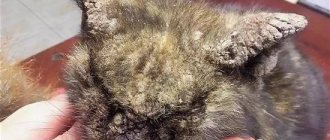Domestic cats bring their owners a lot of positive emotions, brighten up hours of loneliness and even lower blood pressure. But sometimes pets can be dangerous to humans due to the presence of helminths. Even those “homebodies” who never go outside are not immune from infection.
Let's figure out how to remove parasites at home to prevent the development of diseases in your cat and protect others.
Types of deworming
Helminthic infestations occur in all cats, regardless of age, breed and living conditions. This is due to the widespread distribution of microscopic parasite eggs.
They enter the room with clothes and shoes, household items, plants, and even through open windows during strong gusts of wind. Therefore, deworming of pets is a mandatory event that must be carried out once a quarter.
At the same time, it is important to choose the right anthelmintic drugs, taking into account the age of the animal, its weight and physiological condition.
Deworming of cats is a set of measures to free animals from worms or prevent human infection with eggs and larvae of parasites. Veterinarians distinguish 2 types of deworming – preventive and therapeutic.
Preventative
Since the risk of infection with worms exists at any age, preventive deworming should be carried out regularly throughout the animal’s life. The main goal of the procedure is to prevent the appearance of worms in pets.
For cats that do not go outside and eat commercial food, it is enough to carry out preventive measures 2 times a year. For other animals, the frequency of procedures is once a quarter.
Unscheduled treatment for worms is carried out on healthy cats that have had direct contact with infected animals, as well as 2 weeks before vaccination.
Important! In areas where cases of dirofilariasis have been recorded, during the mosquito season it is necessary to carry out monthly specific deworming of cats under the supervision of a veterinarian.
Medical
Therapeutic deworming is carried out when the presence of parasites in a cat is established. Only a veterinarian can prescribe medications, calculate dosages and duration of treatment.
The objectives of therapeutic treatment are:
- destruction and removal of sexually mature parasites, their eggs and larvae;
- minimizing the negative impact of toxic decay products and vital activity of helminths on the animal’s body;
- restoration of normal activity of the gastrointestinal tract.
If, as a result of helminthic infestation, the pet experiences symptoms of intoxication such as vomiting, diarrhea, refusal to feed, perverted appetite or nervous phenomena, then additional infusion therapy is prescribed.
Important! A negative result of a laboratory test of stool for the presence of eggs of intestinal parasites does not provide a 100% guarantee of their absence. This is due to the cyclical release of eggs into the feces by mature helminths. Therefore, it is necessary to re-take the test after 10-14 days.
An expert from Sechenov University talks about how toxoplasma can affect brain function
07/19/2019, RIA Novosti
Toxoplasmosis, a disease caused by the cat parasite Toxoplasma gondii, affects 20 to 40 percent of humanity. A professor at the Institute of Medical Parasitology, Tropical and Vector-Borne Diseases named after E.I. told RIA Novosti about the causes and consequences of this disease, as well as the results of the research. Martsinovsky Sechenov University Evgeniy Morozov.
Scientists have discovered why the same people get into accidents
According to various sources, toxoplasmosis, a disease caused by the cat parasite Toxoplasma gondii, affects 20 to 40 percent of humanity. The majority of the disease is asymptomatic. It has long been believed that it is dangerous only for pregnant women and those with weakened immune systems. However, several recent studies have linked this infection to depression, schizophrenia, aggressive driving and even sexual perversion.
People are not always to blame for accidents
British artist Louis Wain spent his entire life drawing cats - of different sizes and colors, in various poses and often with anthropomorphic features. He had several furry pets at home, he was a member of the Society for the Protection of Cats, and headed the English National Cat Club. Once he even tried to snatch the steering wheel from a bus driver so that he would not run over a cat crossing the road. He ended his life in a psychiatric hospital, where he was treated for a long time for schizophrenia.
Today, it is suggested that the artist’s mental disorder is associated with his incredible love for cats - more precisely, with the single-celled parasite Toxoplasma gondii, which he could well have picked up from numerous pets. After all, the cat is the main host of toxoplasma. There is no direct evidence that the artist suffered from chronic toxoplasmosis, the name given to a disease caused by a parasite. But the fact that Toxoplasma gondii is related to schizophrenia and affects human behavior is no longer in doubt among researchers.
“It’s no secret that Toxoplasma can affect brain function. Mice infected with these parasites chase cats. And the smell of cat urine is the most attractive in the world for them. A person with latent toxoplasmosis also experiences changes in behavior. For example, such people are more risk-averse. When two years ago we examined a hundred drivers who had been involved in an accident due to their own fault, we found toxoplasma in almost half. They were distinguished by a more aggressive driving style - they constantly changed lanes, trying to overtake everyone. For comparison: among 152 volunteers who came for a routine medical examination, that is, completely random people, only a quarter were diagnosed with toxoplasma,” Evgeniy Morozov, a professor at the E. I. Martsinovsky Institute of Medical Parasitology, Tropical and Vector-Borne Diseases at Sechenov University, tells RIA Novosti.
Provoke schizophrenia
Scientists from Sechenov University recently identified a similar ratio of Toxoplasma gondii carriers among schizophrenics. Of the 155 patients suffering from schizophrenia, 62 were diagnosed with toxoplasma - that's 40 percent. As one of the main authors of the work, an employee of the Institute of Medical Parasitology, Tropical and Vector-Borne Diseases Ekaterina Stepanova explained, despite the small sample, the results obtained can be considered statistically significant, and the connection of Toxoplasma with an increased risk of developing schizophrenia is proven.
“We took a narrow pathology - classical schizophrenia. Plus, we were only interested in patients aged 18 to 45 years. It is quite difficult to form a large pool of such people. Therefore, we recruited as many participants as were sufficient for statistics. When processing the data, a correlation was revealed between toxoplasma and schizophrenia. This does not mean that toxoplasmosis is the root cause of the disease. But the fact that it at least aggravates this mental disorder can be stated unequivocally,” the researcher emphasizes.
According to Evgeny Morozov,
The data they obtained is fully confirmed by foreign colleagues.
“While our article was being reviewed in a journal (all scientific works undergo multi-stage verification before publication in specialized publications, which takes from several months to several years. - Ed.), a Danish study on the same topic was published. They looked at all types of mental disorders. Their sample was huge - about 70 thousand patients. And they came to the same conclusions as we did with our 150,” the professor noted.
All in the name of reproduction
Toxoplasma carriers are also often identified among potential suicides. According to a study by American scientists, 43 percent of those who tried to commit suicide have the Toxoplasma gondii parasite in their bodies.
“There may be an explanation here. The fact is that when Toxoplasma is in the human brain, in order to continue its life (and this is impossible to do inside us, because people are a biological dead end for the parasite) it is necessary for this brain to be eaten by a mouse. Therefore, say, as a result of an accident or an accident, there is a chance that the mouse will get to the parasite, and it, in turn, will be eaten by the cat. And thus this chain will be closed. After all, Toxoplasma does not understand where it has ended up, and forces the dead-end owner to behave in such a way that sooner or later the mouse gets to him. This is called modulation of the host's behavior by the parasite. This also happens in the wild. For example, an ant infected with a certain type of parasite climbs up a blade of grass at sunset and freezes there until the morning, which increases its chance of being eaten. This completes the development cycle of the parasite, which matures to an adult state in the body of another animal,” says Evgeniy Morozov.
.
According to Ekaterina Stepanova, worsening mood and a tendency to risky behavior, often characteristic of Toxoplasma carriers, are determined by an excess of dopamine, a neurotransmitter that regulates positive emotions. It is the production of this substance in the host’s body that Toxoplasma can influence.
“Mice infected with the parasite exhibit increased tyrosine hydroxylase activity. This enzyme is the trigger for the synthesis of dopamine. There are reasonable assumptions that Toxoplasma either enhances the action of this enzyme or releases it itself. The result is increased dopamine levels. And this hormone, in turn, is considered a trigger for various emotional manifestations and actions. However, we should not forget that so far the connection between toxoplasma and dopamine production has been shown only in the brain of mice. Such studies have not been conducted on humans,” the researcher clarifies.
Sex, love and parasites
According to the work of Singaporean biologists, infected rodents are drawn to cat urine because the neurons in their brains that sense pheromones are activated, rather than those that are supposed to respond to danger.
In the human brain, this process (if it takes place, because so far these are only assumptions) can lead to unexpected consequences. According to Czech researchers, among fans of non-traditional sexual practices - such as BDSM - there is a high proportion of Toxoplasma gondii carriers. Researchers surveyed the sexual preferences of over five thousand people who donated blood for antibodies to Toxoplasma and probably knew whether they were infected or not.
It turned out that people with toxoplasmosis were more likely than others to be aroused by sexual practices associated with violence or unconventional sexual desires. True, they did not take any real part in such relations. It was enough for them to simply fantasize.
Cats have nothing to do with it
Researchers warn that cats are not the main source of Toxoplasma gondii. Lovers of poorly cooked meat or people who are not very clean are much more likely to pick up parasites.
“Both Ekaterina Viktorovna and I have cats at home, but we do not have latent toxoplasmosis. And most people who keep these animals do not have parasites in their bodies. It’s not the cats who are to blame, but the person himself, who neglects the simplest rules of hygiene,” emphasizes Professor
Morozov
.
Link to publication: ria.ru
How and when to deworm
To effectively remove worms from cats, you need to follow the deworming schedule.
- In spring and autumn, intestinal parasites should be removed from animals that do not go outside. Moreover, their diet should consist only of ready-made industrially produced feed.
- You should remove worms from a cat at home 4 times a year at regular intervals, if food products (meat, fish, vegetables) do not undergo sufficient heat treatment.
- 10-12 days before mating, it is necessary to remove worms from the cat in order to minimize the risk of intrauterine infection of kittens from the mother.
- The kitten should be dewormed 3 weeks after birth.
- 10-14 days before vaccination, it is necessary to deworm both kittens and adult animals. This is a mandatory requirement, since waste products of worms greatly reduce the body’s resistance and can provoke the development of the disease after vaccination.
- To completely remove worms from a kitten and an adult pet at home, antiparasitic treatment is carried out 2 times with an interval of 10-14 days. This will get rid of both mature worms and their larvae.
In areas unfavorable for dirofilariasis and echinococcosis, the timing and frequency of deworming is determined by a veterinarian.
Treatment options
The required treatment method is prescribed by the doctor after receiving the test result. The course of prescribed medications depends on what specific parasite is detected in you, because what destroys one pest will not affect another at all. However, there are cases when it is not possible to identify a harmful microorganism, then the doctor prescribes mixtures of different herbs. Most often it is magnesia, tribulus extract, barberry and grapefruit extract, annual wormwood infusion, walnut extract and bearberry extract. All these ingredients are sold in pharmacies. The mixtures work by creating bacteria that are beneficial to the intestines, which actually fight microorganisms that are harmful to us. If you had liver disease, or you abused alcohol, check this point with your doctor; perhaps you should not use herbs, or you will need to reduce the frequency and number of doses. Remember, most parasites can be identified and treated. Get examined in a timely manner, follow all the instructions of your doctor, and your health is guaranteed!
Rules for deworming
In order for deworming for cats and kittens to be not only effective, but also safe, you need to adhere to certain rules.
- Before ridding a cat of worms, it is necessary to carry out treatment against feline ectoparasites, which are carriers of many intestinal invasions.
- Choose the right drug. For prevention, it is better to use a complex product that simultaneously destroys cestodes and nematodes.
- In order to calculate the dosage, you should find out the exact weight of the animal. Kittens should be weighed before each preventive or therapeutic treatment for worms.
- Select anthelmintic drugs according to the age of the animal. Most manufacturers produce special low-toxic lines of medications for kittens.
- Before using medications, you should carefully read the instructions, study possible side effects and contraindications.
- Anthelmintic medications intended for humans, dogs or other animals should not be administered to cats.
- 4-5 hours after feeding the drug, the animal should be given a sorbent (activated carbon).
In the first hours after using the medicine, you need to watch the toilet. If there is no natural bowel movement, you can use mild laxative syrups such as Lactusan or Duphalac in a dosage of 5-7 ml.
Note! If a cat suffers from an infectious disease, then the use of anthelmintic drugs during this period can sharply worsen the animal’s condition and even lead to death.
Pills and sugar cubes
You can remove worms from a cat using tablets. Some of them selectively act on certain groups of intestinal parasites (they destroy only nematodes or cestodes), others have a complex effect.
| Drug name | Active substance | Spectrum of action | Animal age | Contraindications |
| Azinox | Praziquantel | Cestodes | From 3 months | Last third of pregnancy, lactation period |
| Alben S | Praziquantel + albendazole | Cestodes and nematodes | From 3 months | Last third of pregnancy, lactation period |
| Dehinel | Pyrantel embonate, praziquantel | Cestodes and nematodes | From 3 weeks | Pregnancy, lactation period, weight less than 1 kg |
| Drontal | Pyrantel embonate, praziquantel | Cestodes and nematodes | From 3 weeks | Pregnancy, lactation period, weight less than 1 kg |
| Kanikquantel Plus | Fenbendazole + praziquantel | Cestodes and nematodes | From 3 weeks | First 2/3 of pregnancy, lactation period |
| Milprazone | Milbemycin oxime + praziquantel | Cestodes and nematodes | From 6 weeks | Weight less than 0.5 kg |
| Milbemax | Milbemycin oxime + praziquantel | Cestodes and nematodes | From 6 weeks | Kitten weight less than 0.5 kg, adult weight less than 2 kg |
| Cestal Cat | Praziquantel + pyrantel embonate | Cestodes and nematodes | From 3 weeks | Severe liver dysfunction |
| Poliverkan | Niclosamide + oxybendazole | Cestodes and nematodes | From 1 month | Severe liver dysfunction |
Contraindications to all of the above drugs are:
- individual intolerance to components;
- exhaustion;
- acute stage of an infectious disease;
- rehabilitation period after surgery.
Before using tablets approved during pregnancy and lactation of a cat, you need to consult a veterinarian.
Types of worms in dogs and cats
In dogs, as in cats, there are three groups of worms:
- Nematodes (roundworms).
- Trematodes (flukes).
- Cestodes (tapeworms).
Nematodes are invasive diseases of dogs and cats, the causative agents of which are representatives of the class of roundworms (Nematoda), and are collectively called nematodes. This type of worm parasitizes not only the intestines, but also affects the heart, aorta, eyes, kidneys, bladder and subcutaneous tissue. The most common representatives of this group are roundworms, pinworms, whipworms, toxocaras, hookworms, trichinella, strongoloidiasis, heartworms.
Trematodes are helminth infections caused by representatives of the class of flukes or trematodes (Trematoda). A large number of trematode species are known in animals, each of which is characterized by structural features, life cycle, localization (habitat) and pathogenic effects on the host organism. Trematodes in dogs and cats most often parasitize the liver and intestines. The most common representatives of this group are fascioliasis and opisthorchiasis.
Cestodoses are diseases in dogs that are caused by representatives of the class of tapeworms or cestodes (Cestoidea). They are collectively called cestodiases. Sexually mature cestodes parasitize animals only in the intestines. The larval stages of causative agents of cestodiasis can parasitize a variety of organs and tissues in both animals and humans. The most common representatives of this group are dipylidia, diphyllobothriasis, alveococcosis, taeniasis, and echinococcosis.
Suspensions and pastes
These forms of medications are convenient to use, as they can easily be given to kittens and adult animals for worms at home.
| Drug name | Active substance | Spectrum of action | Animal age | Contraindications |
| Prazitel | Pyrantel pamoate + praziquantel | Cestodes and nematodes | From 3 weeks | First half of pregnancy, lactation period |
| Dironet | Pyrantel pamoate + praziquantel + ivermectin | Cestodes, nematodes, larval stage of dirofilariasis | From 3 weeks | Pregnancy and lactation period |
| Dirofen | Praziquantel + pyrantel | Cestodes and nematodes | From 3 weeks | First half of pregnancy, lactation period |
Worms in cats: symptoms and treatment
Symptoms of helminthiases can include: indigestion, apathy, fever, deterioration of coat condition, allergies. As a rule, an adult organism tolerates helminthiasis more easily and without obvious manifestations, but for young kittens (and puppies) they can be deadly. Roundworms and tapeworms pose a great danger to domestic animals and humans. The main habitat of adults is the intestines of animals, but worm larvae can also parasitize the lungs, kidneys, liver and brain
Drops on the withers
Anthelminthic drops are more often used for the comprehensive destruction of endo- and ectoparasites in cats. They are applied to the skin in the withers area in the dose indicated in the instructions.
If there are young children or other pets in the house, the treated animal should be isolated from them for 1-2 days. Another disadvantage is the need for monthly processing.
| Drug name | Active substance | Spectrum of action | Animal age | Contraindications |
| Professional | Emodepside + praziquantel | Cestodes and nematodes | From 8 weeks | Weight less than 0.5 kg |
| Stronghold | Selamectin | Nematodes, insects, sarcoptoid mites, heartworm larvae | From 6 weeks | Lactating and pregnant females with caution, under medical supervision |
| Advocate | Imidacloprid + moxidectin | Nematodes, fleas, sarcoptic, otodectic and demodectic mites, heartworm larvae | From 9 weeks | Weight less than 1 kg. Lactating and pregnant females with caution, under medical supervision |
These medications should not be applied to wet or damaged areas of the cat’s skin. Despite the fact that the period of breastfeeding is not included in the list of contraindications, veterinarians advise against treatment. If a kitten accidentally licks the medicine from its mother's fur, it may be poisoned.
Is it possible to use folk remedies for worms?
Some information sources refer to the experience of past generations of veterinarians and folk healers. They claim that with the help of onions and garlic you can get rid of worms in kittens and adult pets. However, research and numerous experiments prove the inconsistency of such statements.
The use of such folk remedies for worms in cats, such as onions and garlic, will not relieve them of helminths, but, on the contrary, will cause significant harm to the health of the animals. This is proven by the following facts:
- Sulfur compounds, which are part of onions and garlic, destroy red blood cells and cause the development of anemia.
- Allicin and allisatin, along with their antibacterial effect, provoke a sharp decrease in blood pressure and muscle weakness.
- Onions and garlic strongly irritate the mucous membrane of the cat's esophagus and stomach, which provokes the development of inflammation and ulcers.
- Scientific experiments prove the ineffectiveness of these agents in the fight against helminths.
- Many cats have individual intolerance to onions and garlic, allergic reactions and poisoning.
There is also an opinion that kittens and adults can be given a decoction of wormwood and tansy. This statement is not without foundation, as in some cases it has proven its effectiveness. However, there have been cases of cats being poisoned by these herbs and developing allergic reactions.











